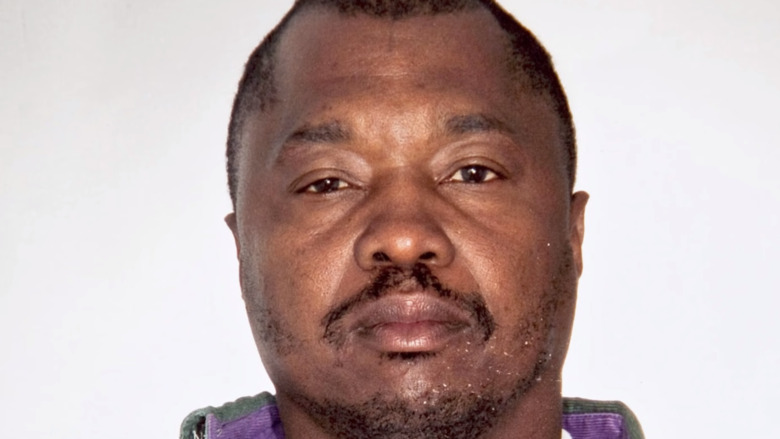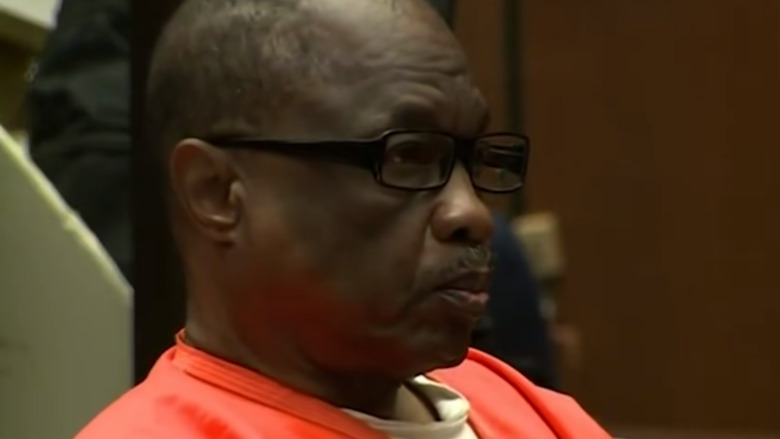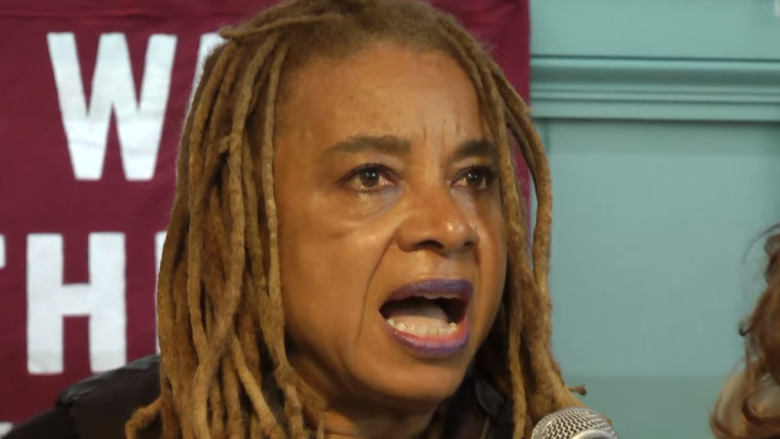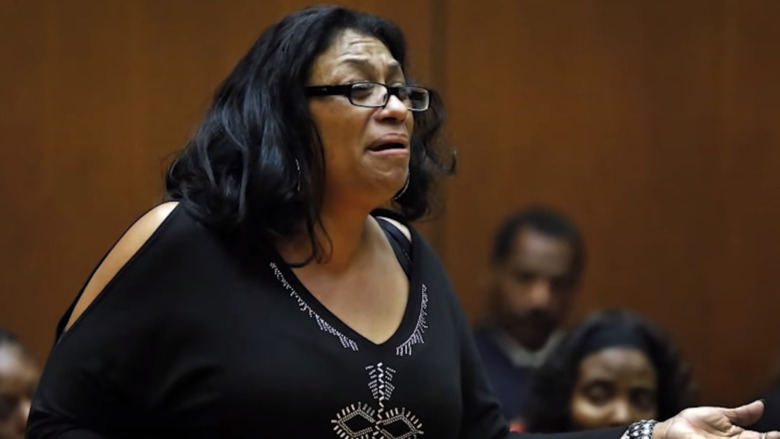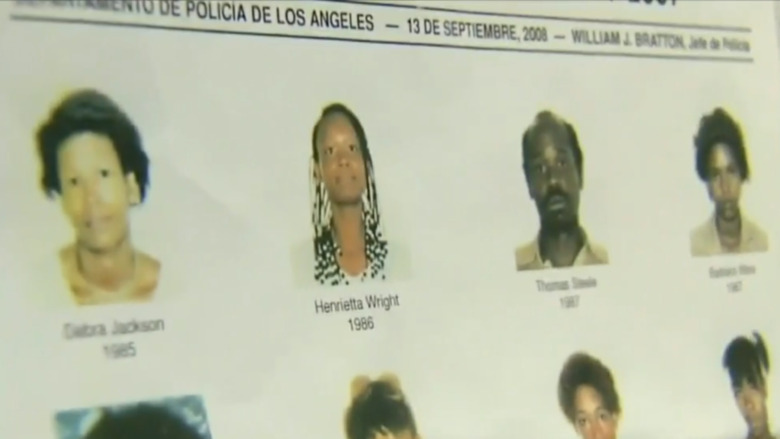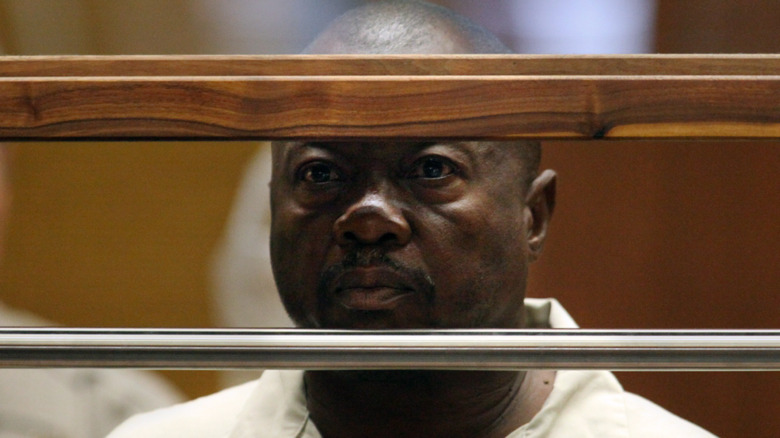How The Grim Sleeper Was Finally Caught
A lot of things can happen in 14 years — it's enough time for a newborn child to become a teenager, for scientists to run clinical trials and get a new drug approved, or for 400 workers to carve 60-foot-tall sculptures of four United States presidents into the side of a mountain. It's also enough time for a serial killer to seemingly go under the radar and avoid getting caught ... and to earn said criminal a uniquely disturbing moniker.
From 1985 to 2007, convicted American serial killer Lonnie David Franklin Jr. performed a series of truly heinous crimes, with an apparent gap of dormancy from 1988 to 2002. According to the Toronto Sun, authorities lumped in Franklin's early murders with other unrelated killings, erroneously concluding that a single culprit, the "Southside Slayer," was responsible for all of them. However, advancements in forensic research eventually helped police determine the true circumstances and suspects behind many of the crimes, including those that Franklin perpetrated.
Here are the facts behind the story of the infamous Grim Sleeper — who he was, what authorities can confirm based on evidence, and why it may never be known the true extent of his horrendous activities.
An unlikely suspect ... or not
When Lonnie Franklin's neighbors found out he was a murderer who had evaded authorities for decades, they were absolutely shocked. In an 2016 article from NBC Los Angeles, people who lived nearby and interacted with him described him as "a happy-go-lucky guy," a generally nice fellow who often provided assistance as a mechanic. A closer look at his life, however, revealed the troubling truth behind his facade.
Born on August 30, 1952, Franklin lived most of his life in the city where he committed his gruesome crimes, according to The Cinemaholic. He had two children with his wife, Sylvia. In an interview with ABC 7, his neighbor and confidant Fernando Cole alleged that Franklin's "first wife" blew their money on crack cocaine, which could explain why he killed women. However, there is little evidence to confirm this. Then again, Franklin didn't exactly live on the straight and narrow — the Los Angeles Times reported that Franklin had been arrested for car burglary, assault, and other small crimes in his neighborhood at least 15 times.
That's not all, though. About a decade before his first confirmed murder, Franklin, then a private in the U.S. Army, joined two fellow soldiers in assaulting a 17-year-old in Stuttgart, Germany. That same night, he attempted to kidnap an 18-year-old, according to People Magazine. Franklin received a three-year, four-month prison sentence and a general discharge from the Army for his crimes. However, he only served less than a year of jail time.
How to (almost) get away with murder
Lonnie Franklin had a simple modus operandi, as the Los Angeles Times reported. He shot his victims, many of whom he lured to his car, in the chest with a .25 caliber handgun, then left their bodies in garbage bins or alleys (via NBC Los Angeles). In an article on True Crime Daily, Deputy District Attorney Beth Silverman noted that in seven of the murders, the victims were shot from an angle that suggested "being seated in the right front passenger seat of a vehicle and the driver turning towards [them] and shooting [them]."
A 2010 article from L.A. Weekly revealed that Franklin worked as a maintenance worker for the Department of Sanitation for nine years, from 1982 to 1991. Franklin's records show a number of paid leaves due to his right shoulder that, for some reason, seemed to get frequently injured. The city even awarded him a monthly disability pension after his retirement.
Interestingly enough, many of those claims took place during the same months his confirmed victims died. And when you factor in how Franklin disposed of many of his victims (wrapping them in rugs before dragging them into dark alleys or lifting and tossing them into large dumpsters), it becomes increasingly unlikely that his recurring shoulder injury was a result of anything work-related. In other words, Franklin may have essentially murdered his way into receiving lifetime financial aid.
Authorities didn't seem to care that much
Due to the low-level nature of his criminal record (and how none of his local crimes involved violence against women), Lonnie Franklin didn't stand out as a potential serial killer. Curiously, in an interview with the Los Angeles Times, homicide detective Dennis Kilcoyne shared that this was not uncommon among serial killers who evade the law. "[Franklin has] danced to the raindrops for a long time without getting wet."
However, L.A. Weekly's crime reporter Christine Pelisek — a journalist who ended up playing a significant role in Franklin's eventual arrest — suggested that the murders may have stayed unsolved for a long time because of other factors. Franklin killed his first confirmed victim, Debra Jackson, with his .25 caliber gun in 1985. At the time, drug-related killings and other crimes were at their peak in various cities, including Los Angeles. Three years later, after ending at least eight lives, the pistol-wielding perpetrator seemingly vanished, along with any active interest from elected officials, influential figures, or the police force to shed light on the murders.
It didn't help that aside from one male, the victims were Black women from working-class families. According to Rolling Stone, this did not fit the usual profile of a serial killer's targets (usually white women). As Pelisek summed up, "Nobody with any pull — no homeowners association, no local chamber of commerce — was demanding answers to 10 murders by the same guy in a poor section of town."
Did the L.A.P.D. keep locals in the dark?
According to NPR, the Los Angeles Police Department noticed a pattern in the killings early on but didn't do much about it. They even gave it an informal name, as stated in an article on Ebony – the "Strawberry Murders," pertaining to the fact that authorities identified some of the victims as Black sex workers who reportedly traded their services for drugs. In 1985, the Los Angeles Times reported that women representatives from various groups protested in front of police headquarters, questioning why it took nearly two years for authorities to warn the public about the fact that a serial killer was on the loose.
In a separate article on NPR, L.A.P.D. Chief Charlie Beck defended the way the police department responded to the Grim Sleeper murders back then. Beck described the L.A. police force back then as being merely a third of its current size, facing a crime rate four times as high.
Perhaps even more disturbing, though, was a detail revealed in "Tales of the Grim Sleeper," a 2014 documentary on the murders. Vanity Fair reported that the cops even had an unofficial classification for killings involving sex workers and drug addicts — N.H.I., short for "no humans involved." According to director Nick Broomfield, this hints at how the L.A. police at the time perceived these members of the community as "disposable." "This behavior wouldn't be tolerated for a minute in a white, affluent neighborhood."
A Black coalition, born out of frustration
The L.A.P.D.'s handling of the murders angered many activists and members of the Black community in South Central Los Angeles (via Ebony). One of them was community activist Margaret Prescod, who compared the department's poor handling of this case to the way they quickly wrapped up the case of Richard Ramirez, the Night Stalker, writes Christine Pelisek. Ramirez committed his murders at around the same time Franklin did. The only difference was that Ramirez did not target Black sex workers.
In her frustration, Prescod and other community activists formed an advocacy group, the Black Coalition Fighting Back Serial Murders. Speaking to NPR in 2016, Prescod stressed that if the Grim Sleeper's crimes took place in a wealthier, predominantly white neighborhood instead of an impoverished community of Black people, they would have been solved much more quickly and efficiently. Prescod even recounted the time they went to the police to get more information about the killings. They allegedly received this response from the person in charge — "Why are you concerned about it? He's only killing hookers." (This wasn't even an accurate assertion, as People's Senior Editor Alicia Dennis noted, Franklin picked up his victims on the street, but not all of them were sex workers.)
A crime reporter helped catch (and nickname) the Grim Sleeper
As one of the first people outside of law enforcement to notice and actively draw connections between Franklin's murders, Christine Pelisek played a key role in bringing the killer to justice. In 2016, the journalist wrote an article for People Magazine describing the breadcrumbs that led to the story she eventually broke.
Her years-long quest began in 2006, while she was working at L.A. Weekly on the crime beat. Pelisek uncovered DNA and ballistic links connecting cases from a list of suspicious deaths of women in the early 2000s to the unsolved killings from 1985 to 1988. Apart from those connections, she also noted similarities in the victims' ethnicities and the manner in which their bodies were disposed of. "It appeared they had been killed by the same person," she wrote.
Additionally, it was Pelisek and her L.A. Weekly editor who came up with the ominous moniker "Grim Sleeper" for Franklin, referencing his apparent 14-year hiatus from killing.
The final victim — and a secret task force
In a 2008 article for L.A. Weekly, Christine Pelisek provided details about what would later turn out to be Lonnie Franklin's last confirmed murder. She wrote about the discovery of 25-year-old Janecia Peters' body near a dumpster on January 1, 2007. At the time, Los Angeles media outlets mistakenly reported that she died from getting stabbed. A subsequent investigation, however, revealed that she was actually shot to death. Furthermore, forensic evidence linked her death to the aforementioned murders from the '80s.
In the same article, Pelisek revealed the existence of the "800 Task Force," a secret six-man task force under the L.A. police force's Robbery-Homicide Unit. According to Pelisek, Los Angeles police chief Bill Bratton ordered the formation of the task force (which took its name from the room at the L.A.P.D headquarters that they used to occupy) specifically to handle the unsolved '80s killings.
Pelisek also highlighted how Los Angeles Mayor Antonio Villaraigosa handled the affair with "extraordinarily poor diplomacy." She even noted that some of the victims' families ended up learning about the details of the case — including the fact that the victims fell prey to a still-at-large serial killer — from the L.A. Weekly team instead of Los Angeles authorities.
DNA, a disguise, and a discarded pizza slice
According to The San Diego Union-Tribune, the police had enough DNA evidence to help them find the elusive killer. Unfortunately, the evidence did not match any of the 1.5 million samples in their DNA database. Dennis Kilcoyne, who headed Chief Bill Bratton's 800 Task Force, described the situation in an interview with TIME Magazine. "We had this beautiful DNA profile on somebody, and we just didn't have a name or a face to go with it."
Working with a state forensics expert, Kilcoyne's team tried a novel, controversial approach — familial DNA searching, or cross-referencing DNA samples from a source, often without permission, to find if they have any possible relatives in a given database. Lonnie Franklin's DNA registered a familial match with his son, Christopher, whose DNA was added to the database after a felony weapons charge in November 2008. This allowed the police to investigate and eventually pinpoint Lonnie Franklin as the serial killer, based on where he lived and the spots where they discovered the victims (via ABC News).
The police confirmed their suspicions through some costumed undercover work – cop dressed as a waiter obtained Lonnie Franklin's discarded pizza crust at a restaurant, enabling them to match his genetic material with those found on the victims. After nearly a quarter of a century, authorities finally arrested Lonnie Franklin on July 7, 2010 (via NBC News).
Finding smoking gun evidence
Upon catching the man who had eluded them for 25 years, the L.A. police wasted no time in obtaining enough evidence to properly convict him.
The day after authorities arrested Lonnie Franklin, they conducted a thorough search of his residence in South Los Angeles, according to the Los Angeles Times. Authorities found a total of 10 guns in Franklin's house, including the F.I.E. Titan .25-caliber handgun that he used to kill his last victim. They also found some loose bullets and a loaded magazine along with the gun, stashed in the top drawer of his dresser.
However, the investigators quickly realized that they were in for an even worse surprise. As the Toronto Sun reported, they discovered Franklin's creepy collection, consisting of nearly 1,000 pictures featuring women and teenage girls. There were also photos of some of the identified victims in the mix. Many of the unwilling subjects featured in Franklin's spine-chilling stack were nude. Some even appeared to be unconscious — or worse, dead. He also kept some of the victims' undergarments in his garage as trophies, as stated in Courthouse News.
Guilty on all counts
After a series of delays, Lonnie Franklin's trial began in 2016, nearly six years after his arrest (via The Guardian). Prosecutors charged him with the deaths of 10 victims, as well as the attempted murder of Enietra Washington (who bears the distinction of being the only confirmed survivor of the Grim Sleeper's attacks). Despite the amount of evidence authorities had against him, Franklin pleaded not guilty, according to the Los Angeles Times.
After nearly three decades, Washington came face to face with her would-be murderer, as she took the stand to testify against Franklin. In her testimony, Washington provided a detailed recollection of her ordeal (as reported by ABC 7). Franklin invited her to step inside his car, which she initially declined. Things went downhill from there rather quickly, as she was shot in the chest before she even realized that Franklin had a gun. Afterwards, Franklin took advantage of her injured state, assaulting her while taking Polaroids of her as she bled. Amazingly, she survived even after Franklin pushed her out of the car and drove off. Furthermore, Washington remembered important information about the vehicle and even the suspect himself. In a 2009 interview for L.A. Weekly, she described Franklin's age, clothes, and general demeanor, as well as noteworthy details about his car.
Perhaps unsurprisingly — and despite his attorney's feeble attempt to pin the crimes on a "mystery man," as reported by the San Francisco Chronicle — Franklin was found guilty of all eleven charges.
If you or anyone you know has been a victim of sexual assault, help is available. Visit the Rape, Abuse & Incest National Network website or contact RAINN's National Helpline at 1-800-656-HOPE (4673).
He could have had many more victims ...
While "Grim Sleeper" is an admittedly catchy nickname, the investigators think it may not be a completely appropriate one for Lonnie Franklin. According to the Los Angeles Times, Franklin may not have actually been inactive during his supposed 14-year "sleep." Authorities took note of 11 other murders during this period that he could have committed. One case, the 1984 killing of Sharon Dismuke, even predates Franklin's first confirmed murder (via Associated Press). The LAist reported that during his trial, prosecutors mentioned five other women who may have been Franklin's victims based on available evidence, including one who died in 2000 (two years before his next confirmed murder). However, the serial killer was not convicted for their murders.
Among the nearly 1,000 photos and Polaroids in Franklin's collection, the L.A. police at the time were unable to identify 180 of the subjects (via People Magazine). Seeking assistance from the general public, investigators did identify most of them, but the identities of 35 women still remain a mystery, though.
In an article on Associated Press, Margaret Prescod mentioned how 200 other women had either been killed or gone missing in the area. It's entirely possible that Franklin had a hand in some of those cases, too.
... But now, questions still remain
It took three hours for the jury to determine the suitable verdict and punishment for Lonnie Franklin, ABC 7 reported. The three-month trial ended with the Grim Sleeper getting the death penalty for every single one of his confirmed murders.
While waiting for his turn on death row, Franklin served time at the San Quentin State Prison in California (via NBC News). Ultimately though, he would not live long enough to receive the full extent of his punishment. On March 28, 2020, prison authorities discovered the Grim Sleeper dead in his jail cell. The Los Angeles Times reported that a pending autopsy would determine the cause of his death. The California Department of Corrections and Rehabilitation lists Franklin's cause of death as "natural causes."
Franklin maintained his innocence until the end of his days. According to an article from the Los Angeles Sentinel, the Grim Sleeper remained stone-faced for most of his trial, displaying neither remorse nor emotion while refusing to defend himself in front of the jury. And unless new evidence turns up in the coming years, what has already come to light is perhaps all that will ever be known about the man whom his only surviving victim called "truly a piece of evil."
